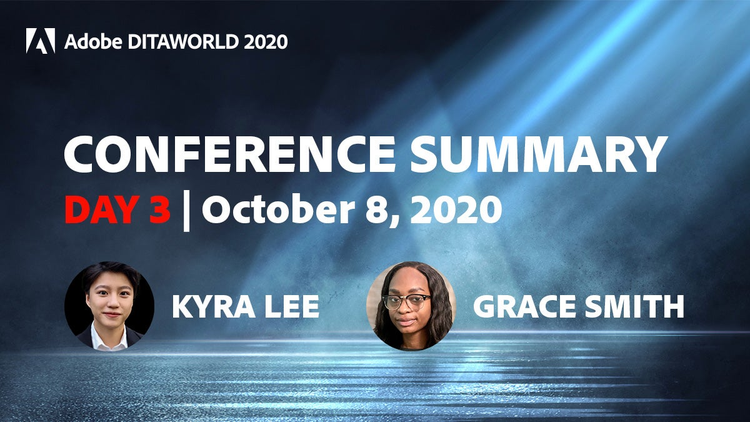Adobe DITAWORLD 2020 – Day 3 Summary by Kyra Lee and Grace Smith

Greetings to all! We are Kyra Lee and Grace Smith, the “resident bloggers” at Adobe DITAWORLD 2020.
The third and final day of Adobe DITAWORLD 2020 (what – already?) started off just as powerful as the two days before it. Stefan Gentz and Matt Sullivan greeted all the excited attendees in the event chat as the minutes counted down to the start of Day 3. It is our pleasure to recap what the presenters had in store for all of us through our Day 3 summary. Let’s get right into it!
In this post:
- [Welcome Note] Kumar (Adobe): Welcome to Adobe DITAWORLD 2020, Day 3
- [Keynote] Schengili-Roberts (Precision Content Authoring Solutions): Structured Content is dead. Long live Structured Content!
- Jensen (Grundfos): Connecting Worlds
- Carter (Bounteous): Building the Brain
- Singh (Adobe): A look behind Quality Content Experiences
- Graat (Smart Information Design): DITA Authoring and Publishing for Everyone
- Clauset (Typefi): Marketing and Technical Communication at Velocity with DITA and InDesign
- Eberlein (OASIS): DITA, where art thou?

## Welcome Note### Welcome to Adobe DITAWORLD 2020, Day 3Vivek KumarDirector of Products at Adobe
Vivek Kumar, Director of Products at Adobe, welcomed all the attendees to day three of DITAWORLD 2020. Vivek started off the welcome note by introducing the talking points for his presentation: Amazon Alexa and computer science.
Amazon Alexa’s components:
- Microphone
- Speaker
- Wi-Fi
- Also: a minicomputer!
Whenever you say “Alexa,” a blue ring lights up, and Alexa wakes up to begin recording and listening for your command. Due to the sound waves, no matter how you may pronounce “Alexa,” the minicomputer can to pick up their name through most accents and begin listening.
Vivek gives us a great analogy to break down how this is possible using two photos: One full photo of a cat and a photo of a cat through a hole in the wall. On the one hand, the computer can see the cat in the full photo. However, the computer is unsure regarding the cat photo where the cat is peeking out of the wall.
Now, if you provide the computer with several pictures of different cats, this increases the computer’s confidence and will allow it to provide you with a percentage of confidence: “Yes! This is X% likely a cat!” This shows that the computer is working through the “fuzziness” to give you the most informed answer possible. The machine is learning and getting better as time goes on. This can be applied to Alexa, as this minicomputer also gets better as time goes on while Alexa learns more.
Computers understand code best, so how do we get computers to work with human language? Through natural language processing. The evolution of NLP has been here for decades. NLP began as a very rule-based function where specifics had to be given. Decades later, the next stage of evolution was the statistical model. This is where things are grouped together with a probability associated with the groups. Machine learning with the statistical model gave very rapid rise to natural language processing. This has helped to get us to where we are now with the rise of natural generation.
We see and use examples of these in our everyday life through Cortana, Siri, Chatbots, Hey Google, etc. On the Adobe side, Adobe Sensei is their AI platform that runs behind the scenes integrating with programs such as Adobe Stock, Adobe Experience Manager, and more to provide the same experience and feedback to users. Vivek’s quick and informative session provided us with the information we needed to continue to learn more through the great lineup of presenters.

## [KEYNOTE] Structured Content is dead. Long live Structured Content!### From Structured Content today to Microcontent and Artificial IntelligenceKeith Schengili-RobertsContent Specialist and Information Architect at Precision Content Authoring Solutions Inc., Canada
Keith Schengili-Roberts, Content Specialist and Information Architect at Precision Content Authoring Solutions, gave us an excellent presentation on how structured and unstructured content evolved. He shared his thoughts on where it is headed. Keith mentions that he was first asked to speak about the future of technical communications. He admits that he is skeptical by nature but plans to survey what we currently know and highlight some industry trends due to his need to find data that backs up his opinion (sounds fair!).
Keith does not believe that structured content is “dead” per se, but he does think we will see significant changes in how it will be used. Keith notes that unstructured content is not necessarily as unstructured as we may think. Although DITA is a niche market, it is a sizable niche worth noting for sure.
Keith’s quick history lesson on technical writing:
- There has always been a need to instruct people on how to do practical things, including:
- Ancient Egyptian medical and mathematical texts
- Certain ancient Greek philosophical works
- Roman engineering texts
- Medieval instructional publications
- Up to the early 20th century, manuals tended to focus on techniques, often including self-improvement aspects. These included many anecdotes that were often prescriptively moralistic and came with suggestions on how to become a better person who could fight/fly/swim/behave.
- This brings us to the beginnings of modern technical writing.
- Starting in the early 20th century, this focused on instructing people on how to work with technology.
- The Ford Model T manual (1919) is a good example of this!
- The beginning of structured authoring
- Much of structured content ultimately derives from studies done in the U.S. Army and Navy from the 1950’s and 1960’s seeking more effective documentation. Typed, modular information helps accomplish this. (This is also where the idea of information mapping comes in)
- Designed to provide quick and easy access to information at the right level of detail to readers.
- Introduced the idea of writing modular structure content (A block is limited to a single topic, blocks are grouped into maps … sound familiar?)
The Rise of Desktop Publishing (and unstructured content) in the ’80s:
Non-structured but allowed for the creation of content quickly and easily. Over time, it was possible to output content to various formats, including PDF and web. This is the beginning of the unstructured VS. structured content dichotomy: ease of use + low overhead VS. significant value add but higher upfront processing.
So, that is the past that brings us to … today!
DITA has continued to evolve:
- The current version is 1.3, moving to DITA 2.0 likely next year.
- Started out with three topic types (concept, task, and reference).
- Precision content adds two more: process and principle.
Note: Keith also believes there is real promise in Lightweight DITA!
Keith points out that most content today is unstructured content. A study he uses as an example notes that unstructured content is thought to make up roughly 80% or more of all enterprise data. The world’s most popular technical writing tool to date? Word (spooky!). However, Keith informs us that unstructured content has more “structure” than we may think. He provided us with an example of MS Office’s version of XML. While it does not separate content from formatting per se, it does contain a semblance of structure that can be extracted and used for other applications.
To show us who uses DITA, Keith showed us a pie graph that provides data that may not be surprising to many. DITA usage by industry sector, Q4 2020:
- 26% – Computer software
- 13% – IT and Services
- 12% – Other
- Remaining percentage: many different groups (such as higher education, oil and energy, machinery, financial services, etc.)
So, which firms get the most benefit from using DITA? Keith took all the firms from the previous slides and classified them to gather this information: DITA appears to work best at scale.
- Almost two-thirds of the firms using DITA are “large firms” (500+ employees)
- “Small Firms” (1–5 employees) make up the minority
- 60% of these large firms that make 100M to 1B+ use DITA
Who is not using DITA: smaller firms? Since structured content requires a substantial investment of time and money, the benefits of using DITA, albeit worth it, may not be apparent at first. Many of these smaller firms are also adopting a hybrid approach. This approach is hard to find in a large firm that it is using DITA exclusively.
DITA’s primary “superpower” is its content reuse, but it has several! The chief business strengths of DITA outlined by Keith include:
- Content reuse
- Lower localization costs
- Content/formatting separation
- Multi-channel publishing.
However, we must pay attention to the less obvious benefits of DITA:
- Advance product SEO
- Ability to provide a better customer experience
- Topic/semantic structure works well with emerging systems, like chatbots.
Customer experience has become a business imperative. Before the digital transformation, key business interactions with customers happened in the physical world. However, our customers moved online (so our physical content followed!). Technical documentation has come to the “fore” since it often contains targeted information that the customers are looking for.
As we moved on to discuss chatbots and AI, Keith noted that although we are in the early days, these methods have the potential to become facets within the industry. Chatbots take one of two paths when working with external content (including technical content):
- Digests existing material which it incorporates directly within itself, or
- It refers to appropriate material a user wants via metadata.
Think of chatbots as a new complementary channel for content delivery that works best with structured content. Although DITA has a role here, it is not directly in the chatbot “conversation” but provides technical content when and where it is needed. Although we are still within the early days, it is worth noting that IA and chatbots are not being used exclusively with structured content. Also, the role of the “technical writer” is changing. People claiming to use DITA are not just employed as traditional technical writers these days. There are so many more titles now! Some include:
- Information architect
- DITA architect
- Content architect
- Applications engineer
- And many, many more …
For larger companies working at scale, it makes sense to have these roles. Efficiency is worth it. Keith’s final prediction: we are still in the early majority phase but at the end of this stage.
A few of the notable questions from the Q&A pod:
Lara asked: Does lightweight DITA mean fewer available elements? Matt answered: Yes, LwDITA is a limited subset, easier to understand, producing fully compliant DITA content.
Lara also asked: Any idea when DITA 2.0 will be out? Stefan’s answer: This is a good question for Kristen James-Eberlein from the OASIS Committee during the last session today.

## Connecting Worlds### From Adobe Experience Manager to Microsoft Azure Blob Storage AppsBo JensenIT Coordinator at Grundfos, Denmark at 3M, USA
Bo Jensen, IT Coordinator at Grundfos, brought us another interesting customer story by sharing how Grundfos is connecting their DITA content to AEM and Microsoft Azure for reuse, and why he believes that cloud-based editing is the way to go.
To start, Bo gave a short introduction about himself and Grundfos, a company in Denmark that has been producing pumps since 1945. As you can imagine, their pumps have gone through many years of innovations, and their latest products can be connected to your smart devices and be fully controlled using the Grundfos remote app!
In the “old” days, user manuals were only published as PDFs, and users had to flip/scroll through pages to find the information they needed. Bo thought that the lack of usability and findability made their content highly ineffective in today’s standards. However, he was not allowed to switch to DITA authoring right away as there were many different departments at Grundfos. Doing so might create an issue of an inconsistent brand image. He had no control over any output formats (i.e., web content) except for PDF files. To combat that, he created DITA Merge XML files.
What is DITA Merge XML?
DITA Merge XML files are created when you use the DITA Open Toolkit to produce a merged output from the entire DITA Map structure without further processing. When you generate a PDF from a DITA map with DITA-OT, it first goes through a merging process where DITA-related items are resolved, and then it converts the information into a PDF file. Bo stopped the output and ended up with a merged XML file that is completely solved and has all the content.
How is DITA Merge XML used at Grundfos?
- Web department: Instead of creating HTML files for each product, Grundfos’ web department can simply pull Bo’s content from the DITA Merge XML files resting in AEM to plug into their website.
- Troubleshooting: With the metadata in their DITA Merge XML files, their system can find specific messages/instructions for their customers to remotely troubleshoot with their smart devices. The future is NOW!
- Augmented Reality (AR) According to Bo, it takes around two months to train new employees to learn how to assemble pumps. Using AR dramatically speeds up this process.
Then, Bo gave us a live demo of his workflow (woohoo!), so we could better understand the benefits of using DITA Merge XML files to drive content. If you are interested in seeing how he edits content and publishes with AEM, feel free to watch the recorded session. To keep this summary short and sweet, I am just going to list some of the main takeaways from his demo:
- DITA Merge XML benefits:
- Keeps content updated and accurate
- Streamlines the workflow
- Easy navigation
- Simple structure
- Web/cloud-based editor is the way to go
- It streamlines the editing process and ensures that your content stays updated and accurate.
- If everything can be done in a browser, information becomes more accessible and portable. Now, being able to work remotely (from anywhere) makes collaboration easier and more flexible.
- Authors should always focus on improving content, instead of the layout and design. Bo argued that we should make content, layout, and formatting independent from the author. Stylesheets can take care of that nowadays. Authors should focus more on improving the content and creating value for their customers.
A few of the notable questions from the Q&A pod:
Q: What are your goals for DITA for your company?
A: The goal is to be able to use DITA as a common language across departments. There are a lot of possibilities with DITA, and many departments could leverage its potential.
Q: Where do you see the future for cloud-based editors?
A: I’m a big advocate of cloud-based authoring because writers can just work on a thin and portable machine from anywhere. When you update content in a browser, that edit automatically applies to every single system inside the company.

## Building the Brain### XML Documentation for Scalable Technical KnowledgeSteven CarterAssociate Principal Architect at Bounteous, USA
Steven Carter, Associate Principal Architect at Bounteous, USA, covered XML documentation for scalable technical knowledge with his presentation “Building the brain.” Bounteous is composed of engineers, data scientists, marketers, analysts, strategists, designers, and digital specialists. Their combined expertise, ideas, and innovation allow them to succeed.
Steven’s presentation began by giving a brief overview of DITA and Adobe Experience Manager. He emphasized that Adobe Experience Manager is a comprehensive content management solution that is powerful and fully extensible. It provides technical communicators with a straightforward authoring interface. It enables companies with a high technical documentation volume to map complex information at scale and create consistent customer experiences by bringing marketing and technical content onto the same platform.
- Advantages include:
- Cross-channel consistency for content
- Complete solution – author review and publish
- Close interoperability with adobe analytics and target for content delivery and personalization
- Customizable and extensible through custom development
- The value of XML Documentation for Adobe Experience Manager:
- Delivers a uniform experience to end users
- Increase enterprise content velocity
- Reduce total cost of ownership by up to 40%
- Efficiently manages the content lifecycle end-to-end with a One-Adobe Solution
- Additional benefits for XML Documentation for Adobe Experience Manager:
- Interoperability
- Reuse
- Modularity
Steven then takes us through the interesting and inspiring F5 story. In collaboration with F5, Bounteous began the Adobe Experience Manager wesite migration. They leveraged XML Documentation for Adobe Experience Manager to generate Adobe Experience Manager pages from easyDITA documents. This resulted in resource efficiency, improved user experience, and increased engagement with the F5 Knowledge Center.
Their challenge was to facilitate increased engagement with the F5 Knowledge Center by efficiently managing resources and improving the user experience. Their solution: upgrade to AEM 6.4 and leverage the XML connector. Bounteous partnered with F5 to migrate all technical documentation pages for legacy CQ 5.3 to AEM 6.4 and create new templates for easyDITA documents.
Their implementation goal: implement XML Documentation for Adobe Experience Manager to automatically generate AEM web pages out of technical documentation from easyDITA. Through their key implementations, they successfully completed the migration process: this increased engagement and lowered maintenance requirements. The robust platform was built using AEM to improve the way F5 and its customers engage with its Knowledge Base.
Steven began the XML Documentation section of his presentation with a quick overview of AEM DITA support. Everything standard = works OOTB immediately! An example AEM site output was shown to include breadcrumbs for navigation, references to other related articles, and build-in search capabilities all OOTB.
Then, together, we took a closer look. Steven showed us how DITA authoring in AEM looks like with a web-based resource example within both the Author and Source mode. Some of the many DITA authoring in AEM benefits he outlined were as follows:
- Simple to use with a lot of power
- Editing and rendering utilizes the same components that are used for rendering the final AEM site output (true WYSIWYG!)
- XML source is always available when needed and can be edited in the same interface
- Colored Conditionals, condition pre-sets, baselines, etc. are all authorable from within the AEM interface
- Existing marketing assets and content can be utilized in the technical documentation
- Change and revision tracking is a powerful way to aid your approval workflows
- Dark mode (Kyra and I love this!)
- Tracked changes available along with “ask for review”
- The ability to merge changes from different versions
- The ability to import unstructured content, entire documents, and specific sections of content (Steven’s favorite!)
Key Takeaway and Tips
Just a few of the many advantages that Steven outlines:
- DITA can be authored in the same interface that marketing teams utilize
- Can reduce overhead by combining your tools and processes
- Increase the rate of publishing while reducing the overhead of authoring
- Content is immediately searchable, allowing users to find what they are looking for quickly with no extra setup necessary
- Leverages the rich tooling that already exists within AEM, which is the leader within the CMS space
- Content, designs, and assets can be shared between the technical writing team and the marketing team as they live on the same platform (very big deal!)

## A look behind Quality Content Experiences### How globally distributed teams can collaborate to create Quality Content ExperiencesDivraj SinghSenior Solutions Consultant at Adobe, USA
Divraj Singh, Senior Solution Consultant at Adobe, explained why AEM is the best CCMS tool for globally distributed teams to collaborate and create quality content experiences.
He started his presentation with a question for the audience: “What determines the quality of content?” I am sure we all have different definitions and standards for “quality.” And the truth is that there is no one way to measure the quality of content. The bottom line is that high-quality content is valuable for users and helps businesses reach their goals.
According to Divraj, three factors drive good content experience:
- Content is reviewed and updated regularly
- Messages are consistent in style, grammar, and terminology
- Timely delivery
Typically, we create the content and send it for review. This turns into an iteration of editing and re-editing, and finally, the content is approved for publishing. To reduce the costs and improve outcomes, Divraj said that we should answer these questions: Why are we reviewing? What are we reviewing? How should we review it?
Why: driven by business goals
Reviewing content adds value and helps personalize customer experiences. It also prevents information silos as team members are encouraged to share ideas freely. Ultimately, a content review should help your team meet its business objectives.
What: driven by consumer experience
What you review should be driven by consumer experiences. What do they like and need? Consumers nowadays need content in different formats (i.e., PDF, HTML, Word, etc.), which could increase reviewers’ workload as they are required to review the same content in various formats. But Divraj said there’s a better way to review: Structured authoring.
Structured authoring (like DITA) allows you to focus on only the content’s quality, not its layout. Since the content is free of presentation, reviewers are freed from reviewing the same content in multiple formats.
How: driven by process and tools
Traditionally, reviewers must manually review content and send edited files back to authors. The authors then must incorporate the comments into their copies and send it for review again. This not only wastes resources but also time and effort. Sometimes, manual errors like missing an edit could also happen. This is impractical in every way.
The main message is that you must have the right tool and process to effectively review content. This is why XML Documentation for Adobe Experience Manager is the ideal CCMS tool for authoring.
AEM is a web-based collaboration space that helps you manage structured content, create and track review tasks, review content, and collaborate with team members.
Notable Review Features:
- Create and track review tasks: Shows you related information like tasks statuses, reviewers, and due dates
- Author, review, and publish within one single tool
- View comments and approve or reject edits
- Generate reports about your documents and projects
When Divraj was giving a live demo on how to leveraging AEM’s full potential for review and collaboration, the Q&A section of the chat was properly blowing up! There were so many questions (all good questions too!) that the session went around 10 minutes overtime – for the first time during the conference.
Unfortunately, due to time constraints, Divraj was not able to answer all the questions. But again, if you have any questions about AEM, you can always contact techcomm@adobe.com or check out their website.
A few of the notable questions from the Q&A pod:
Q: Can we review a topic that is re-used in multiple locations at the same time?
A: Yes, because it is being reviewed in different contexts.
Q: What tool is used for reviews? Can reviewers use a free tool to review content, or will everyone have to buy a license?
A: AEM is a web-based CCSM tool, so you would need a license to access the tool.

## DITA Authoring and Publishing for Everyone### Adobe FrameMaker: What Adobe offers the DITA Author that no other tool can matchJang GraatCEO at Smart Information Design, Netherlands
Jang Graat, CEO at Smart Information Design, Netherlands, presented us with key information that thoroughly explains what Adobe FrameMaker brings to the DITA authoring space that no other tool can match. Jang begins by outlining some of the common problems people may face while using DITA:
Number 1: Moving to DITA can break production
- According to Jang, migrating to DITA means for most companies having to move all of their content into the new DITA system to continue to publish. This is not an issue, however, with FrameMaker.
- With FrameMaker, Jang uses the analogy of “you are changing the engine without stopping the car (2012)”.
- FrameMaker does not care if it’s structured or unstructured content; it is all the same to FM! This is something that Jang and those from Adobe had never seen before (exciting, right?).
Jang provided us with a quick demo to show us this with the sample UserGuide book. He showed us the DITA version of the same document, which showed the true WYSIWYG experience FM provides. Jang then excluded the Systems.fm file, added the Systems.dita file to the book, then generated an updated TOC to see the changes. This shows that everything still works and the content was able to be updated smoothly.
Number 2: DITA is complex
- This is something that we have heard, and many will agree with.
- Full DITA is a daunting tool, especially with all the available elements. DITA requires all of those elements to be useful for all business domains.
- Tool tested for the solution: Lightweight DITA. However, Jang believes LwDITA may not be the best answer to the problem.
Number 3: Customizing DITA is hard
- The current processes for customizing DITA may be enjoyed by some serious DTD/XML experts, but the reality is one typo can break the entire DTD.
- Customising in FM: Customise DITA interface included since FrameMaker 2019
- Jang provided a quick demo to show the built-in customize DITA tool he created.
- First, he showed the complete list of elements available to place after the topic tag. He then went through and de-selected topics he did not wish to deal with then placed the constraints. A much smaller element list is then present (neat!).
Number 4: Customizing DITA output is hard
- If you want to customize your DITA output, you may be using the DITA open toolkit. Jang’s thoughts: good luck! A polished group of experts will be necessary for such a task.
- Customizing the look-and-feel in FM (for example, the complete responsive HTML5 output): a feature that has been in FM since 2015. Jang showed how editing the publishing settings is comprehensively laid out and fully customizable and provides you with style previews, so you know exactly what to expect.
- Jang notes that the layout customization specifically for responsive HTML5 is the easiest he has seen. You do not need to know a lot about CSS styling to work with it. All the layout components are self-documented right in the settings.
Number 5: Reuse in DITA takes (extra) time
DITA Reuse (currently):
- Click “Insert Conref” or “Insert Cross-Ref”.
- Open the file containing the reuse item.
- Search for the reuse item in the file.
- If not found, open another file (repeat until found).
- If the file is already in use/someone is editing it, it may be locked: impossible to insert at this point.
- Click on “Insert”.
Why is it this way? Well, it was made by software developers. The developer looks at the technique and says, “the goal is inserting a Conref.” However, the user’s goal is to create content. This is where the disconnect is.
So, what should reuse for an author look like? (great question! If only I could take credit for asking it…)
- Decide that a note is needed in the topic.
- Selecting <note> from the elements catalog.
- See that there are ready-made notes to reuse (neat!).
- Think to yourself: “Hey, this is easier!”.
- Click on “Insert”.
Sounds easy, right? This process is exactly what Jang’s plugin (currently in progress) aims to do soon.
Donna, a DITAWORLD 2020 attendee, mentioned thoroughly enjoying Jang’s FrameMaker based session, saying: Jang is outgoing and positive. We need that in these weird pandemic times.
Another comment, from Sally, in agreeance: Yes, it is nice to see a FrameMaker related session, my company is just not big enough to make the jump and expense of AEM work for us, and I was worried FM might be going away. Glad to see a FrameMaker session.
Stefan and Matt quickly assured Sally (and us all) that FrameMaker is there to stay! With the recent Summmer 2020 release of Adobe FrameMaker just three months ago, and the new subscription-based model that allows faster, more agile development and quicker release of new features, FrameMaker is stronger than ever!

## Marketing and Technical Communication at Velocity with DITA and InDesign### XML Documentation for Adobe Experience Manager and InDesign Server unitedCaleb ClausetVice President of Product at Typefi, Australia
Caleb Clauset, Vice President of Product at Typefi, captured everyone’s attention with his engaging and informative presentation. He talked about how easily we can manage DITA content within Adobe Experience Manager, publish it to the Adobe InDesign Server, and how Typefi can be used to unite Adobe Experience Manager with InDesign. Caleb’s work focuses on InDesign automation and figuring out how to expand InDesign’s use outside its traditional strongholds (magazine, newspaper, books, etc.).
Customers are more informed and empowered today, and what matters to them is a beautified experience. Content management and reuse across channels are even more important today. Therefore, AEM is the next generation of digital asset management. It is a full tool with features that help its users understand how content can be reused, relocated, and managed. It promotes the idea of experience-driven documentation that reacts to customer needs like a living, breathing thing.
InDesign, despite it being traditionally overlooked in tech comm, remains THE tool for professional design. In 2019, Adobe estimated that the market potential for InDesign is a minimum of 45 million users worldwide.
But there is a problem! There is a disconnect between AEM and InDesign. There is no direct channel to integrate the two tools. AEM would pull content out of the InDesign file, and you cannot natively reuse AEM assets in InDesign files.
So, how do we integrate InDesign with AEM? How do we extend our reach with our content? The answer is with Typefi.
Typefi is an automated publishing system that could be built onto Adobe InDesign Server. It allows you to pull XML from AEM through a workflow and work with DITA directly within InDesign. It is a complete, end-to-end delivery solution for superior print and PDF outputs. Using Typefi also reduces time to market by up to 80%!
Caleb then gave a live demo on how Typefi works. These are the main takeaways:
- You can use different workflows for different authoring purposes with Typefi.
- Typefi enables a fully automated environment that uses things like GREP rules to drive content design and layout.
- Typefi supports a series of different InDesign-specific actions.
- You can integrate different kinds of XML into your workflow.
What a glorious labor saver!
To end, Caleb noted that this work is never finished. Information architecture and business processes will need to change over time to adapt to changing business.
A few of the notable questions from the Q&A pod:
Q: How can you automate the application of a style within your content? Perhaps with something like metadata?
A: Accessibility is one thing we stress at Typefi. We want everyone to be able to consume our content, so we have spent a lot of time figuring out how to use XMP to add elements like ALT text or format to the design. That is what we do to automate that.
Q: Can authors make edits in InDesign and flow that back into AEM?
A: It can be done, but it can be quite painful. Therefore, InDesign is mainly used as an output server.

## DITA, where art thou?### A Retrospective from the OASIS DITA CommitteeKristen James EberleinOASIS DITA Technical Committee
Kristen James Eberlein, part of the OASIS DITA Technical Committee, provided a useful retrospective of where DITA has been and where it is going.
Questions to consider:
- What was DITA designed for?
- Have other problems emerged since DITA was designed and donated to OASIS? New expectations?
- How is the landscape different now than it was in 2004?
- Has DITA addressed the problems that it was designed to resolve?
History of DITA: IBM
- Origins in a user technologies’ work group, commissioned 1998/1999. Goal: work ahead and assess needs.
- Made available to the external community in 2001, through a developerWorks article and associated downloads (early grammar files, scripts, etc.)
- DITA was intended to be an architecture: “A new architecture for authoring, producing, and delivering technical information”.
DITA: What it IS and what it is NOT
- DITA IS an architecture and a standard!
- DITA IS NOT a tool or application.
- DITA IS NOT a processor.
- Many applications (like AEM) bundle DITA DTDs and the DITA Open Toolkit.
Landscape at IBM at the turn of the century: a huge and custom SGML markup: IBMIDDOC. By using this, IBM was locked into an expensive tool stack.
- Arbortext Editor (highly customized for IBM)
- Omnimark
- XML professional publisher (XPP)
This meant that if you were a new-hire at IBM, there was a long ramp-up time as you learned everything.
Familiar these days (yet uncommon back then), IBM did:
- Multichannel publishing
- Translation into many languages
Products began to merge into solutions; however, it was difficult to absorb content from business partners and acquisitions.
So, what did DITA need to do to solve IBM’s problems?
- Support investment in legacy documents: SGML, Bookmaster, Lotus Notes, and many more.
- Handle frequent acquisitions and multiple business partners.
- Provide infrastructure for (then new) information centers
- Solve expensive problems, such as:
- Lock-into proprietary tool chain
- Long ramp-up time for information developers
- Expensive contract support for information development
- Extensive (and expensive) localization.
(Think: Does any of this sound familiar to you?)
The rationale for DITA: What did it need to support?
- Topic orientation
- The promise of XML: greater reuse, semantic specificity, interchangeability
- Next-generation information delivers: “Smart content that lets end users search on things that matter to them (get the right information at the right time)”
Kristen then took a step back to go over their history specifics:
2001: Made available through developerWorks
2004: Donated to OASIS (The DITA Tech Committee was born, 2004 to present)
Approved as a standard across DITA 1.0 in June 2005 to DITA 1.3 in December 2016.
Kristen then shifted back to the present and urged us to look at how different things are now.
- DITA is used in many industries.
- DITA is used for much more than software and hardware: Medical info, pharmaceutical info, etc.
- The primacy of web-delivered content (web-delivered content rules!)
- The decline of the book paradigm and rise of topic orientation
- New use cases for DITA:
- Microcontent for bots and AI
- Semantically rich content for medical records
- Another big difference in 2020: there is a wide variety of tools that exist! From free/open-source (Github, BitBucket, DITA-OT) to subscription-based (CCMS, Conversion, Localization).
It is worth noting that these many services are quite inexpensive compared to 1998/99.
We then investigated the authoring resources available in 2020:
- Fewer technical writers: more documentation is being written by SMEs
- Interest in Markdown
- Documentation automatically generated from code
- Growth of authoring tools that hide XML from authors
- Has the quality of documentation suffered? Kristen says: probably.
Regarding the landscape in 2020, there has been a quiet (yet thorough) adoption by large companies, especially those for whom information is a revenue-generating product:
- Amazon
- Medical information
- Publishing
- Governments
Unfortunately, this is more of a pain for small implementations, where documentation is a cost center. Luckily, there is support for topic-orientated authoring also in some non-XML tools like Adobe RoboHelp.
To wrap up: Has DITA delivered on its promises? Kristen says: Yes!
- Support for topic orientation? Check!
- Enable reuse by reference? Yes!
- Ease of interchange? Yes!
- Richer environments of less expensive tools: You got it!
- Wider availability of authors with requisite skills: Yes!
- Ability to meet future needs: Double yes!
However, that does not mean that there are pain points in DITA, even present day:
- Lack of corporate support for DITA TC and DITA-OT
- Perception of complexity
- Increased expectations
Kristen then provided us with a DITA reality check: DITA is XML. XML is inherently complex. It’s a good idea to build XML and XSLT skills in-house or retain a consultant for support. The benefits of content reuse hinge on solid and thoughtful information architecture and a more in-depth business process analysis. This work is not free.
So, where is DITA going?
- DITA 2.0 (hopeful release by ~December 2021?).
- DITA 2.0 will be the first backward-incompatible release. However, it allows to reduce technical debt, correct earlier design choices, and deliver DITA in a different way!
- The pandemic may cause a slight setback but brace yourselves! It is coming!
- Lightweight DITA:
- No solid guess for LwDITA release, however it will be after DITA 2.0 as DITA 2.0 acts as a base for it.
- (Wish list item #1) Additional adoption resources
- (Wish list item #2) Greater corporate participation in DITA Technical Committee and the DITA Open Toolkit project.
Some highlights of DITA 2.0:
- Native support for multimedia (audio and video)
- Simplified chunking
- New hardware domain
- New diagnostics component for troubleshooting
- Removal of deprecated items
- (For practitioners) ability to control where attribute specialization is applied
- (Task topics) ability to nest steps
Kristen’s advice: Find out if your company is an OASIS member. If they are, think about whether you (or whoever represents your company’s interests in DITA) could be involved with the DITA Technical Committee!
If your company is not currently a member of OASIS… perhaps consider joining? This creates a wide range of possibilities that may be very cost-effective. For any further questions, feel free to reach out to Kristen for more information.
A great question from Lara: Can we participate as individuals in OASIS? Kristen’s answer: Absolutely! companies can buy an associate membership that allows one person to represent the company for $1200 a year, or an individual member can participate with their own intellectual property for $300 a year.
Wrap-up
There you have it! Just like all of life’s best things, this conference must come to an end. The last day of Adobe DITAWORLD 2020 was packed full of content. The presenters undoubtedly went all out to ensure the content was clear, informative, and plentiful. Cannot say we are surprised – this is Adobe DITAWORLD, after all.
All presentations and experiences shared throughout all three days were very well-received by the audience, other presenters, moderators, and us, too! As this conference was a lot of great information to take in, having access to the recordings, slide decks, and blog posts (ha-ha) will prove to be very useful tools for reflection. So, please do take advantage of these resources. We know we will!
It was a great pleasure to watch the conference from the comfort of our own homes, and a privilege to write these daily blog posts for all 5,857 of you (whoa!) in the over 90 countries worldwide. Now, please ensure that you:
1. Take care
2. Stay safe
And … (drum-roll)
3. Register for Adobe DITAWORLD 2021!
See you all next year!
Related Links
Read also: